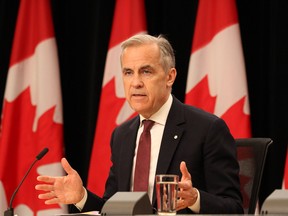
Article content

THIS CONTENT IS RESERVED FOR SUBSCRIBERS ONLY
Subscribe now to read the latest news in your city and across Canada.
- Exclusive articles from Barbara Shecter, Joe O'Connor, Gabriel Friedman, and others.
- Daily content from Financial Times, the world's leading global business publication.
- Unlimited online access to read articles from Financial Post, National Post and 15 news sites across Canada with one account.
- National Post ePaper, an electronic replica of the print edition to view on any device, share and comment on.
- Daily puzzles, including the New York Times Crossword.
SUBSCRIBE TO UNLOCK MORE ARTICLES
Subscribe now to read the latest news in your city and across Canada.
- Exclusive articles from Barbara Shecter, Joe O'Connor, Gabriel Friedman and others.
- Daily content from Financial Times, the world's leading global business publication.
- Unlimited online access to read articles from Financial Post, National Post and 15 news sites across Canada with one account.
- National Post ePaper, an electronic replica of the print edition to view on any device, share and comment on.
- Daily puzzles, including the New York Times Crossword.
REGISTER / SIGN IN TO UNLOCK MORE ARTICLES
Create an account or sign in to continue with your reading experience.
- Access articles from across Canada with one account.
- Share your thoughts and join the conversation in the comments.
- Enjoy additional articles per month.
- Get email updates from your favourite authors.
THIS ARTICLE IS FREE TO READ REGISTER TO UNLOCK.
Create an account or sign in to continue with your reading experience.
- Access articles from across Canada with one account
- Share your thoughts and join the conversation in the comments
- Enjoy additional articles per month
- Get email updates from your favourite authors
Sign In or Create an Account
or
Article content
Prime Minister Mark Carney says Canada will meet its two per cent of GDP commitment to NATO by next spring though that’s only a down payment, as NATO seems likely to agree to a 3.5 per cent or higher target this spring. The true value of defence spending is hard to estimate. But one thing we know for sure: more money spent on guns means less money spent on butter.
Article content
Article content
Economists consider national security one of the key “public goods” that can only be provided by governments, not the private sector. But without knowing the benefit of national security, how do we know how much money to spend on defence?
Article content
Article content
In theory, the value of defence is arrived at by summing what each citizen would be willing to pay for the next bit of it. The optimal amount of military spending is where the sum of that willingness to pay just equals the cost of the next bit of defence. Any more than that and society values it at less than it costs to produce. You don’t want to produce things, not even defence, that are valued at less than they cost so acquire that amount of defence capacity and no more.
Article content
By signing up you consent to receive the above newsletter from Postmedia Network Inc.
Article content
In practice, however, you’ll never really know how much people value defence. They’re likely to free ride by reporting that they aren’t willing to pay anything, in hopes the bill will be handed to someone else.
Article content
Rather than polling citizens about benefits, governments rely on voters to make decisions at the ballot box. Military spending becomes a priority when there are wars: it reached almost 40 per cent of GDP in World War II. Otherwise, Canadians and their federal government put military spending on the back burner. Defence expenditure slipped from about three per cent of GDP in 1965 to 1.37 per cent in 2024, even as total government expenditure rose from 30 per cent of GDP to 43 per cent.
Article content
Article content
Tired of the U.S. providing two-thirds of NATO’s military spending, Donald Trump 1.0 called on laggards like Canada to get to two per cent pronto. Now he is pushing a five per cent target though even the U.S. doesn’t spend that (Poland is currently closest at 4.1 per cent). Europe already supports a 3.5 per cent target.
Article content
Article content
Using Parliamentary Budget Office estimates, military spending would have to be $55 billion higher than currently planned in 2029-30 if Canada were to spend 3.5 per cent of GDP rather than two per cent. With today’s geopolitical turbulence, the peace dividend is over: more economic resources will have to go to military purposes. More guns, less butter. That trade-off is unavoidable.
Article content
Even so some Keynesians are arguing that military spending is good for the economy because of its “multiplier effect”: a dollar spent on defence will increase demand for goods and services provided by other sectors, with a net benefit that’s therefore greater than $1.
Article content
In a recent memorandum, RBC looked at the ripple effects of defence expenditure based on estimated multipliers. Although multipliers vary by the type of military expenditure RBC suggests that on average a dollar of military spending increases GDP by more than a dollar, with the highest multipliers being for services (e.g., raising salaries) and intellectual property. Statistics Canada estimates an average industry output multiplier of 1.9, with each million dollars of output creating 8.9 jobs on average.

.jpg) 7 hours ago
1
7 hours ago
1
 English (US)
English (US)